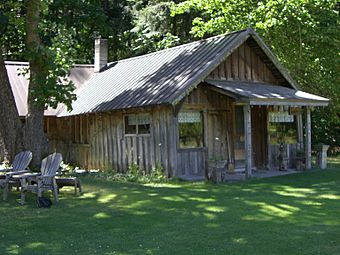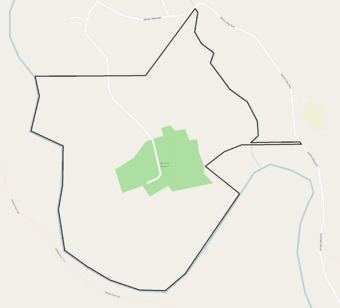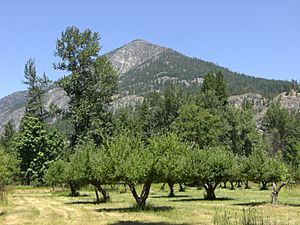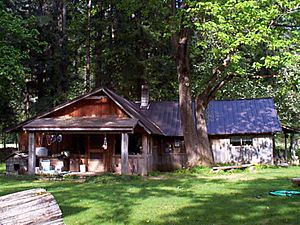Buckner Homestead Historic District facts for kids
Quick facts for kids |
|
|
Buckner Homestead Historic District
|
|

Buckner family's main house
|
|
 |
|
| Location | Along Rainbow Lane, about 2.6 miles (4.2 km) northwest of Stehekin, in Lake Chelan National Recreation Area |
|---|---|
| Nearest city | Stehekin, Washington, USA |
| Area | 105.5 acres (42.7 ha) |
| Built | 1889-1950 |
| Architectural style | Log and wood-frame |
| MPS | North Cascades National Park Service Complex MRA |
| NRHP reference No. | 88003441 |
| Added to NRHP | February 10, 1989 |
The Buckner Homestead Historic District is a special place near Stehekin, Washington, in the Lake Chelan National Recreation Area. It shows what life was like for early settlers in the Lake Chelan area. This historic district includes 15 old buildings, outdoor areas, and even ruins. It also has over 50 acres of apple orchards with hand-dug irrigation ditches!
The oldest building on the farm is a cabin built in 1889. The Buckner family bought the farm in 1910 and lived there until 1970. That's when the property was sold to the National Park Service. The Buckner Cabin was listed as a historic place in 1974. The rest of the Buckner farm became a historic district in 1989. Today, the National Park Service takes care of the Buckner homestead. They use it to teach visitors about pioneer farm life in the Stehekin Valley.
Contents
Who Started the Farm?
The land that became the Buckner farm was first settled by William Buzzard in 1889. People called him Bill Buzzard. His property was several miles north of Lake Chelan, along the Stehekin River. It was the farthest homestead (a place where a family settled and built a home) from the main Stehekin settlement.
Buzzard built a one-story log cabin on his land. He also cleared some areas for animals to graze and for growing crops. In 1892, Buzzard sent 1,000 pounds of potatoes about 50 miles down Lake Chelan to the town of Chelan, Washington. He sold the rest of his potatoes to local miners.
By 1895, Buzzard had planted a small apple orchard. He was also growing cabbages along with potatoes. Buzzard also cut wood on his property and sold it to the steamboat company that traveled on Lake Chelan. In 1903, Buzzard officially bought his homestead from the U.S. government.
The Buckner Family Takes Over
In 1910, Buzzard sold his property to William Buckner for $5,000. Buckner was from California. Buzzard wanted to be paid $50 each month until the full amount was paid. After selling the farm, Buzzard moved to Chelan. He lived there until he passed away in 1919.
When Buzzard died, Buckner only owed one more payment. So, he used that last $50 to buy a headstone for Buzzard. Buzzard was buried in the Old Fraternal Cemetery in Chelan.
In 1911, William Buckner brought his wife and three sons to the farm. They called it the "Buckner ranch." When they arrived, much of the land was covered with tree stumps. The previous owner had cut and sold the timber. Over the next few years, the family cleared enough stumps to plant a 50-acre apple orchard.
The Buckners also created a clever irrigation system. It moved water from Rainbow Creek to their orchard. The main irrigation canal and watering ditches were all dug by hand. These ditches totaled over four miles (6 km) and were dug during the summer of 1911.
At first, the Buckner family only lived on the ranch during the summer. They would move back to California in the fall to avoid Stehekin's harsh winters. But they returned every spring to work on their farm. Over the next few years, they built many different buildings. These buildings protected animals, stored farm equipment, and preserved food.
Eventually, the Buckner ranch had more than a dozen structures. These included a barn, workshop, milk house, smokehouse, root cellar, chicken coop, outhouse, and sleeping cabins for guests. They also built a mile of wooden fence around their entire property.
In 1915, Harry Buckner, one of William's sons, decided to live at the ranch all year. In 1919, Harry married Olive, a young lady from Stehekin. She joined him at the ranch. William Buckner and his wife continued to live in Bill Buzzard's log cabin during the summer until 1924. So, Harry made one of the sleeping cabins bigger to be a home for himself and Olive.
Harry and Olive worked hard to make the farm a comfortable place. They raised pigs, cows, and chickens. The family grew vegetables in their garden and planted large flower beds. When they wanted electric lights, Harry turned a smokehouse into a power generator house. Harry also built a playhouse for his three young daughters. When the girls were older, he built a concrete swimming pool that was filled by the farm's irrigation system.
In 1922, the Buckners built a large packing shed to protect their apple harvest. In the 1930s and 1940s, the farm produced between 4,000 and 5,000 crates of apples each season. That was enough fruit to fill their 40-foot by 100-foot packing shed! This was the busiest time for the farm.
Olive Buckner passed away in 1948. Harry continued to live on the ranch and later remarried. In 1953, the packing shed roof fell in because of heavy winter snow. In 1956, Buckner stopped farming. He became Stehekin's postmaster. In 1970, Buckner sold the homestead and most of his property to the National Park Service. He kept a small piece of land for his retirement home. He lived there until he passed away in 1976.
The National Park Service Today
After buying the Buckner property, the National Park Service made it part of the Lake Chelan National Recreation Area. The Buckner homestead and farm have been kept safe. The National Park Service uses it as a place to teach visitors about pioneer life in the Stehekin Valley.
It's not a commercial farm anymore, but horses still graze in the Buckner's pasture. Water still flows through the irrigation ditches. And apples are still picked from the orchard every fall. Some changes have been made to the buildings to keep them in good shape. Many of the structures are still used for their original purpose. The main house, for example, is now home for a National Park Service employee.
Because of its special history, the Buckner Cabin (built by William Buzzard) was listed as a historic place in 1974. In 1989, the rest of the Buckner farm joined the cabin to create the Buckner Homestead Historic District.
Historic Buildings and Features
The Buckner Homestead Historic District has 15 buildings, different outdoor features, some old ruins, and about 50 acres of apple orchard. The orchard is watered by hand-dug ditches.
- The original William Buzzard Cabin was built in 1889. It was a one-story log cabin, about 16 feet by 18 feet. In 1910, Buzzard added over 23 feet to its length, making it 16 feet by 42 feet. After buying the homestead, Buckner added a huge river-stone fireplace and chimney in 1911. The cabin has a stone and concrete floor, log walls, and a wood shake roof. The Buckners used the cabin as their main home until 1924. Then it became a guest house. The National Park Service fixed up the cabin in 1980 and made it stronger in 1999. The cabin is listed as a historic place.
- The Buckner homestead's main house was first built in 1914. It was a 12-foot by 18-foot summer sleeping cabin. The Buckner family added a 16-foot by 18-foot living room in 1915. They added another bedroom and a large fireplace in 1921. A third bedroom and a kitchen were added in 1925. The National Park Service added a porch in 1983. They put new roofs on the house in 1975 and again in 1999. It is a wood-frame house with weatherboard walls and a metal roof.
- The Buckner homestead hay barn and workshop was built in 1949. It is a two-story building with a large hay loft and a pointed roof. The building is 21 feet by 24 feet. It is a wood-frame building with weatherboard siding and a metal roof. The main entrance is a large wooden sliding door on the north side.
- The Buckner's Milk House was built in 1916. It is a 6-foot by 8-foot one-story, wood-frame building. It sits on a raised concrete base with an overhanging pointed roof. The National Park Service fixed up the building in 1979.
- The "Delco House" provided electricity for the farm. It was first built as a smokehouse in 1915. It was changed to hold the Delco power generator in 1925. It is a one-story, wood-frame building on a 4-foot by 8-foot concrete base. The building has weatherboard siding and a wooden shake roof.
- The farm's wood and harness shed was built in 1950. It is a one-story, log-frame building on a concrete base with a wooden pointed roof. The building is 12 feet by 20 feet. The National Park Service replaced the shed roof in 1980. They did more preservation work in 2005.
Other buildings on the Buckner farm include a sleeping house, tool sheds, a root cellar, chicken coops, an outhouse, and a children's playhouse. The Buckner's swimming pool is also listed, but it is kept empty for safety reasons. Old farm equipment, like the Buckner's 1911 Hercules Stump Puller and several farm trucks, are also on display. The National Park Service takes care of the Buckner's orchard, picking its apples every fall.




